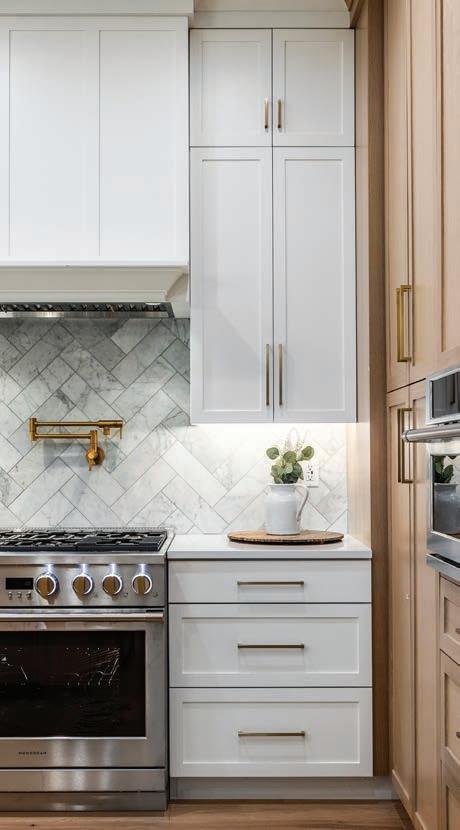
10 minute read
How Does a Deep Freeze Affect a Home’s Foundation?
The blistering cold temperatures throughout the country may put some properties at risk of damage. Watch out for these signs.
By Melissa Dittmann Tracey
Many areas of the country are experiencing blistering cold weather, even those that aren’t used to freezing temperatures. Rapid temperature swings could cause substantial issues to a home’s foundation, warns Groundworks, a nationwide foundation services company.
Every year, one in 60 homeowners file claims related to water damage or freezing, according to the Insurance Information Institute. That accounted for nearly 20% of all insurance claims in 2020—at an average cost of more than $10,000 per claim. The price tag to fix a damaged foundation could easily stretch even higher.
Realtor® Magazine caught up with Brian Black, Groundworks’ director of sales training and business development, to learn more about how a harsh winter could be affecting a home’s foundation and the signs of potential damage.
How can cold, wintry weather damage a home?
Brutal cold is damaging in several ways, depending on your home’s foundation type. If you live above a crawl space, your home’s pipes are typically located beneath the floors. Freezing temperatures can cause pipes to burst, resulting in extensive damage. Frozen pipes are more than just frustrating. According to the Federal Emergency Management Agency, a one-inch flood caused by a broken pipe can result in about $25,000 in damage.
If you have a basement or slab foundation, it’s the concrete you need to worry about. Concrete is porous, meaning it absorbs water. Water expands when it freezes, causing concrete to break and crack. When the spring thaw eventually arrives, water can easily find its way into your home through these cracks.
Furthermore, frozen ground is one of the three causes of inward basement wall movement. The other two are the weight of the soil and the weight of water in the soil. When these three contributors combine, it pushes basement walls inward.
What are the signs to look for?
For homes with a crawl space, the first sign of a problem is cold floors. As the issue progresses, homeowners will notice a problem when a faucet is no longer working. If none of the faucets are running, the frozen pipe is probably near the main water line.
Homeowners with basements and slab foundations should look for cracks both inside and outside their home. Cracks can vary in size and direction. That can help tell professionals why the problem is occurring. Inward wall failure will show as horizontal and vertical cracks on the basement wall or even drywall.
What should homeowners do if they suspect any damage to their foundation?
It’s best to have a foundation specialist inspect any cracks as soon as possible. Your home’s foundation supports everything in your house. If it’s damaged, you’ll discover costly secondary problems very quickly. So, it’s best to act fast.
Foundation work isn’t a DIY project. Choosing a company with the knowledge and tools to best solve your specific foundation problem is the best choice. Look for a company that customizes repair options to your home, offers long-term warranties and has a history of working with the specific soil and climate in your area.
What makes a home vulnerable to frozen pipes?
First, it’s important to understand where the majority of your pipes are located. In different parts of the country, pipes are installed in different areas of a home. In warm-weather regions, pipes are weatherized to handle summer heat and are placed in exterior walls and attics. But this makes them vulnerable to damage during rare cold events. In cooler climates, pipes are often located within the floor joists in basements and crawl spaces. The best way to prevent frozen pipes and create a more comfortable environment overall is to seal out any outside air through encapsulation. But there are some easy steps you can take to beat the freeze and keep water flowing right now. Consider insulating pipes, allow for a constant drip, open cabinets to allow for warm air circulation and remember to leave the heat on and keep a consistent temperature throughout your home during the winter.
What can homeowners do to “winterize” their property?
The number one most effective route to winterize your crawl space is through encapsulation. Sealing your crawl space from outside air and circulating warm, conditioned air protects pipes and creates a more comfortable living environment. Plus, you can save nearly 20% on your energy bills.
Homes with basements have a similar process involving sealing the rim joist where pipes enter and exit the home, along with moving warm air throughout your home. All homeowners should check for plumbing leaks and look to improve energy efficiency by replacing filters or adding a smart schedule on their thermostat before sub-zero temperatures and blustery winter weather hits.
Melissa Dittman Tracey is a contributing editor for Realtor® Magazine. Reprinted from Realtor® Magazine Online, February 2023, with permission of the National Association of Realtors®. Copyright 2023. All rights reserved.
Nearly Two-Thirds of Americans Own Their Homes
There were about 9.2 million more homeowners in 2021 than a decade prior. The U.S. homeownership rate increased to 65.5% in 2021, up from 64.7% in 2011.
By The National Association of Realtors®
While the U.S. homeownership rate has continually increased during the last decade – to 65.5% in 2021 (from 64.7% in 2011) – the Black homeownership rate has not kept pace with increases of other racial groups. Also, people of color endure significant buying challenges throughout and even after their home purchase, according to a report released today by the National Association of Realtors®.
The 2023 Snapshot of Race and Home Buying in America examines homeownership trends and challenges by race and location to explain the current racial disparities in the housing market. Leveraging NAR’s latest Profile of Home Buyers and Sellers data, the report explores the characteristics of who purchases homes, why they purchase, what they purchase and the financial background of buyers by race.
Homeownership Trends
The report found there were about 9.2 million more homeowners in 2021 than a decade prior, but homeownership rates varied significantly by race. The Black American homeownership rate – 44% –increased less than half of 1 percentage point (43.6% in 2011) and continues to lag well behind Hispanic Americans (50.6%), Asian Americans (62.8%) and White Americans (72.7%). Consequently, the homeownership gap between Black Americans and any other racial group has grown, especially when compared to White households (29%), representing the largest homeownership gap in 10 years (26% in 2011).
Conversely, Asian Americans (5 percentage points) and Hispanic Americans (4 percentage points) experienced the biggest homeownership rate gains over the last decade. The Asian American homeownership rate of 62.8% is an all-time high. White American homeownership grew by nearly 3 percentage points and has been consistently around 70% since 2017.


“Unfortunately, the incredible affordability challenges of the last year have hit minority home buyers more than White buyers,” said Jessica Lautz, NAR deputy chief economist and vice president of research. “Black buyers are more likely to be first-time buyers, who are more sensitive to changes in mortgage interest rates, while White buyers are more likely to have housing equity to rely on as they make a housing trade.”
Racial Inequalities in Housing Affordability
Black homeowners spend more of their income to own their homes than all racial groups, with 30% being cost-burdened – defined as spending more than 30% of their income on housing. That’s followed by Hispanic Americans (28%), Asian Americans (26%) and White Americans (21%).
More than half of Black renter households (54%) spend more than 30% of their income on rent, the most of any racial group. About 30% of Black renters are severely cost-burdened – defined as spending more than 50% of their income on rent – representing nearly 2.5 million households. By contrast, 22% of White renters are severely cost-burdened, representing 5.1 million households.
After comparing the qualifying income to purchase the typical home with the median income of renter households, NAR estimates that while 17% of White renters can afford to buy the median-priced home, only 9% of Black renters can nationwide.
“Even among successful home buyers, Black Americans have lower household incomes, which narrows the available pool of inventory they may be able to afford and makes their journey into homeownership even more difficult in this limited housing inventory environment,” Lautz added.
Racial Disparities in the Mortgage Market
Beyond affordability, Black and Hispanic home buyers also face extra challenges in getting a mortgage. Black Americans have the highest denial rates for purchase and refinance loans. According to Home Mortgage Disclosure Act data, 20% of Black and 15% of Hispanic loan applicants were denied mortgages, compared with about 11% of White and 10% of Asian applicants. Further, denial rates for Black Americans are even higher for home improvement loans. Black Americans were denied applications for nearly 17% of loans for a home purchase, 17% of loans for refinancing and 51% of loans for home improvement.
Homebuyer Demographics by Race/Ethnicity
Using data from its latest Profile of Home Buyers and Sellers report, NAR analyzed the characteristics of recent home buyers, their reasons for purchasing, the steps they took in the homebuying process, and the ways buyers financed their home purchase based on race. Among all home buyers, White Americans made up the largest share (88%), followed by Hispanic Americans (8%), Black Americans (3%), Asian Americans (2%) and other (3%).
For down payments, Black Americans drew down 401(k)/pension funds more than any other group (16%), which increased 2 percentage points from last year (14%). Asian Americans received gifts (22%) and loans (7%) from a relative or friend more than all other racial groups.
Hispanic Americans had the largest share of student loan debt (46%), followed by Black Americans (33%), White Americans (17%) and Asian Americans (13%).
Discrimination in Transactions
In addition to being asked about their recent homebuying experience, home buyers were asked if they had experienced or witnessed discrimination during their real estate transaction. Half of Hispanic American home buyers said they experienced steering toward or away from specific neighborhoods, followed by 29% of White, 12% of Black and less than 1% of Asian American home buyers. Forty-six percent of Hispanic American home buyers experienced discrimination by the refusal of a homeowner or agent to show property, followed by 24% of Black, 15% of White and less than 1% of Asian Americans. Thirty-nine percent of Black American home buyers reported discrimination through home appraisal, followed by 17% of Asian, 9% of White and less than 1% of Hispanic Americans.
NAR Advocacy
NAR works to ensure Realtors® are active leaders in the fight to close racial homeownership gaps. NAR co-chairs the steering committee for the Black Homeownership Collaborative(link is external), which has outlined a seven-point plan to create 3 million net new black homeowners by 2030. NAR has also enhanced the real estate industry’s efforts to end housing bias. Its “ACT!” fair housing plan, launched in 2019, emphasizes “Accountability, Culture Change and Training” to advance fair housing in the industry. NAR’s interactive training platform, Fairhaven, puts real estate professionals in simulated situations where discrimination in a real estate transaction can occur. Also, the association’s implicit bias video and classroom trainings offer strategies to help Realtors® provide equal professional service to every customer or client.
To increase the nation’s housing inventory, NAR advocates that all levels of government: support the construction of housing that is affordable to the typical consumer; preserve, expand and create tax incentives to renovate distressed properties and convert unused commercial space to residential units; and encourage and incentivize zoning reform. Expanding new-home construction by an additional 550,000 units a year for 10 years would create 2.8 million new jobs and generate more than $400 billion in economic activity. NAR and the Rosen Consulting Group’s Housing is Critical Infrastructure: Social and Economic Benefits of Building
More Housing report examines the causes of America’s housing shortage and provides a range of actions that can effectively address this long-time problem.
The National Association of Realtors® is America’s largest trade association, representing more than 1.5 million members involved in all aspects of the residential and commercial real estate industries. The term Realtor® is a registered collective membership mark that identifies a real estate professional who is a member of the National Association of Realtors® and subscribes to its strict Code of Ethics.
Kristen Bagley
Mandy Bullock
Bret Charlesworth
Blake Edwards
Erin Eldredge
Whitney Fautin
Alicia Holdaway
Brian Jensen
Jeff Justice
Megan Kessimakis
Adam Kirkham
Carolyn Kirkham
Ryan Kirkham
Angie Nelden
Mark Overdevest
Jacquelin Perry
Susan Poulin
Scott Robbins
Brett Sellick
Laurel Simmons
Scott Simpson
Liz Slager
Mony Ty
Tricia Vanderkooi
Amy Volcic
Thomas Wright
At Summit Sotheby's International Realty, we believe in a full-service partnership with our sales associates. The goal? Provide support that ranges from world-class marketing to concierge level transaction management, enabling our agents to reach and exceed their personal GCI goals by spending more time in their businesses. Explore how these services have impacted the businesses of some of our top sales associates.
Brett Sellick
It became apparent about five years ago that the world was starting to demand video in real estate marketing. I was attempting to figure this out on my own when DeAnna Robbins approached me about a move to Summit Sotheby’s International Realty. The company’s in-house advertising agency had videographers and was already executing what I wanted to do and more. Having the ability to deliver video with each new listing is huge and cannot be understated! I have been able to more than quadruple my business since moving to Summit Sotheby’s International Realty. I’ve embraced all that the company has to offer. I love Summit Sotheby’s International Realty and am so grateful that I get to be a part of it!



Alicia Holdaway
One of the greatest benefits of being at a company like Summit Sotheby’s International Realty, is the caliber of people you are surrounded with. Not only from an agent perspective, but also the staff as well. Our in-house general counsel, Shane Norris, is a legit life saver. The fact that I can simply pick up my phone and call Shane, run through any challenge, question or concern with him, is such a huge value. We are handling incredibly important financial transactions for our clients and to know that I have the expertise and wisdom of someone like Shane at my fingertips is a huge peace of mind not just to me, but my clients as well.
ADAM KIRKHAM
I love the Sotheby’s International Realty brand. I had no idea how respected the brand was before joining. The outcome of my joining Summit Sotheby’s International Realty is that I’ve dramatically increased the price point of average listings and have gained new opportunities simply because of the blue sign and Sotheby’s brand. When potential clients see the brand, they know they can expect quality, professionalism and best-in-class service.
Laurel Simmons
My transaction manager makes me feel like I’m part of a team. I value this so much. I always know there is an additional layer or safety net keeping the flow of my transaction on-track. It is like clockwork as each milestone approaches. This support allows for me to focus even more of my attention on my clients, providing them face-to-face interaction and service.






